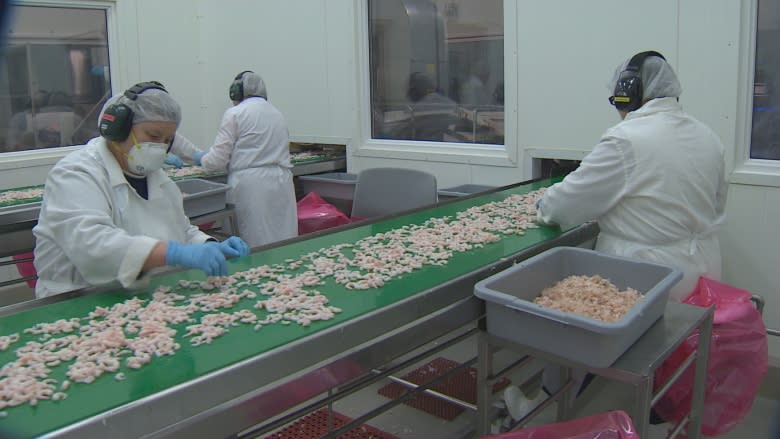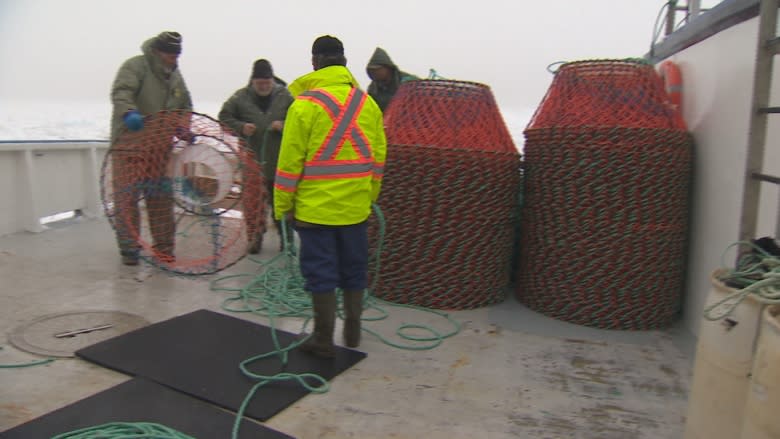'I'm shivering in my shoes:' Plant workers fearing the worst as shellfish resource collapses
The bleak reality of what's unfolding in the Newfoundland and Labrador fishery is beginning to hit home for those who depend on the industry for a livelihood, and it's taking a toll.
"If you could see me right now I'm shivering in my shoes because of what I know is coming," Trudy Byrne said Tuesday, her voice breaking as she spoke.
Byrne works at a shellfish processing plant in St. Anthony, one of more than 100 people who depend on the operation for a living.
But with shrimp and crab stocks collapsing, and quotas slashed for the upcoming season, Byrne is predicting some very hard times again.
"You feel like crawling in a hole and crying your eyes out," she said. "It's total devastation."
Limited production means reduced work
St. Anthony Seafoods is one of eight plants in the province that processes northern shrimp, but work is expected to practically dry up this season.
The federal government announced a 63 per cent cut to the shrimp quota last week, and that's on top of smaller cuts a year ago.
With so much less raw material coming out of the ocean, those on the production line in St. Anthony say they expect three or four weeks' work with shrimp processing.
Twenty-five to 30 weeks have been common in past years.
There was also a 22 per cent average cut to the snow crab quota this week, the second blow in a one-two punch to an already reeling industry.
The crab and shrimp harvests have been an economic driver in coastal communities for many years, and most of the more than 17,000 people who worked in the fishery last year derived a vast majority of their income from these two species of shellfish.
But the backbone of the industry is now badly broken, and some are forecasting an economic crisis.
Plants like St. Anthony are expected to see far less production this season, which will mean substantially less income for workers like Byrne.
Qualifying for employment insurance benefits will be a struggle.
"Back a few years ago, I probably worked about 132 days without a day off. Now you sit by the phone and you wait, hoping for a call," she said.
"It's like a make-work program now."
Some plants will close, says minister
With half of the shrimp plants in the province located on the Northern Peninsula, the region is expected to be hit especially hard, but regions like Fogo Island are also preparing for some hard times.
That's because the northern shrimp quota for the entire inshore fleet in area 6 has plunged from roughly 19,000 tonnes in 2016 to just over 7,200 tonnes, or roughly 16 million pounds.
About five years ago, the Fogo Island Co-op was processing 11 million pounds of shrimp annually, but that expected to drop to less than three million this year, said general manager Phil Barnes.
"So where we were five years ago, we had a hundred days work for two shifts. That's 14 weeks work, to now this year 23 days work for two shifts," Barnes said, calling the quota cuts a "tremendous loss."
Fisheries Minister Steve Crocker has predicted that some plants will likely close, and Barnes agrees.
He said the fishery is, in large measure, unsustainable.
The picture for crab production on Fogo Island is equally bleak, Barnes added.
"We've gone from four-and-a-half million pounds of crab to 10 days production this year," he said.
Barnes said processing plants will have a difficult time providing work for employees, and fishing enterprises will have a challenge keeping their crews because there so little to catch.
He predicts larger enterprise owners will begin selling their boats, and returning to a smaller inshore fishery, eking out a living with small amounts of crab and groundfish.
The picture for the processing sector is even more dire, he said.
"Our plants will shut down because we won't have the supply to put through," he said.



